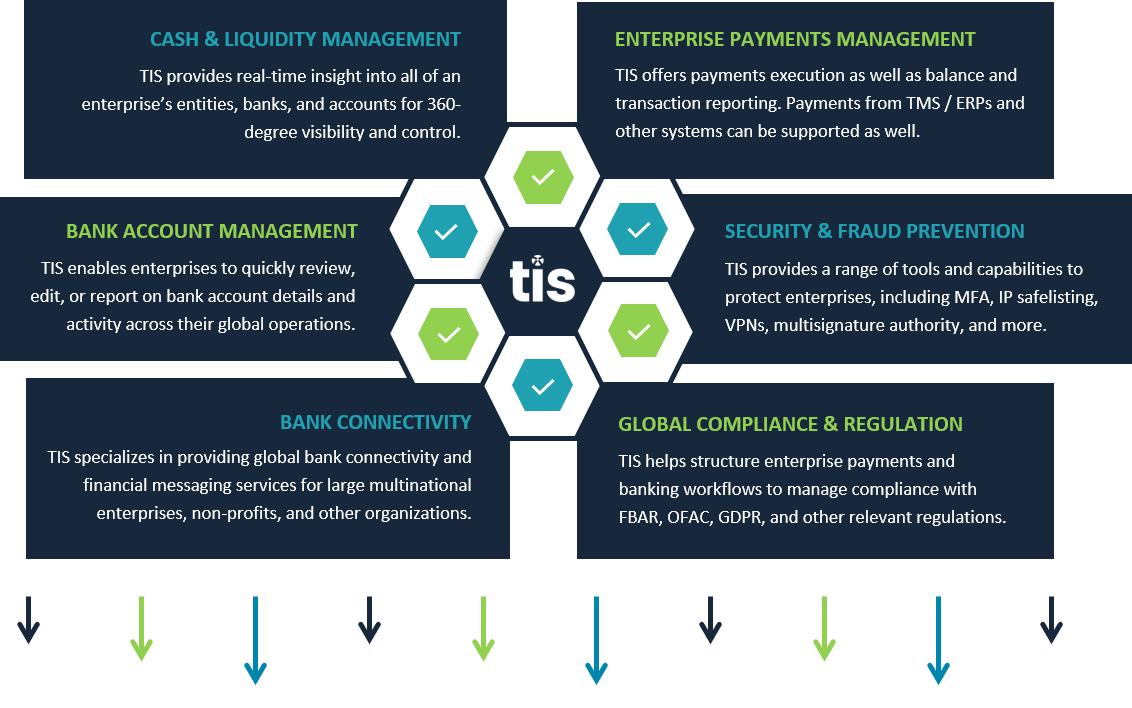Your new home for fixed income
07-03-2022 | treasuryXL | Refinitiv | LinkedIn | Your new home for fixed income
07-03-2022 | treasuryXL | Refinitiv | LinkedIn | Your new home for fixed income
03-03-2022 | treasuryXL | Treasury Delta | LinkedIn | Treasury Delta, our Irish fintech partner, recently formed an alliance with Blokken, a Dubai-based fintech aggregator. This strategic partnership will bring further innovation and digital technology deployment to the corporate treasury ecosystem within the Middle East. Credits: Blokken Source
02-03-2022 | treasuryXL | Gtreasury | LinkedIn |
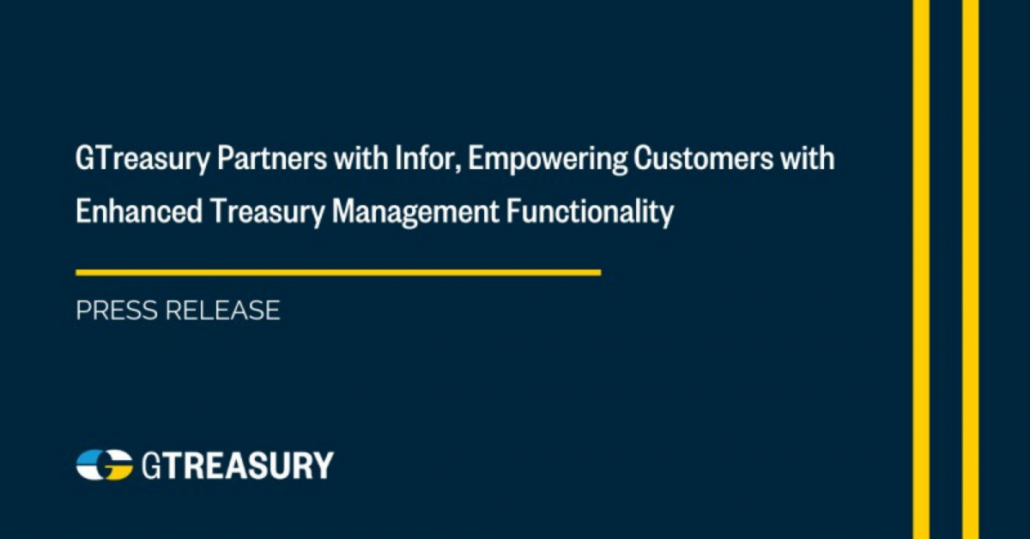
CHICAGO, Ill. – March 2, 2022 – GTreasury, a treasury and risk management platform provider, today announced its partnership with Infor, a global leader in industry-focused business cloud software solutions. The deal enables GTreasury and Infor customers to benefit from new automation and data integration between GTreasury’s digital treasury platform and Infor’s powerful cloud-based ERP platform. The integrated workflow will help eliminate the challenges of relying on various siloed systems to accomplish business-critical treasury and accounting tasks.
With this partnership, the GTreasury platform will utilize an application programming interface (API) to connect data from Infor’s cloud financials ERP solution, Financials & Supply Management. This data includes bank statements, payments (accounts receivable and accounts payable, along with bank confirmations), Positive Pay automated fraud detection, and general ledger (GL) journal entries that encompass applicable treasury management system sub-ledger entries such as cash, financial instruments, treasury payments and settlements, and hedge accounting.
The integrated data visibility and automated command across applicable balances and transactions give GTreasury and Infor customers the ability to analyze and act on cash positions quickly and confidently. Customers can also access all of the treasury, finance, accounting, and risk management products available through the GTreasury platform.
“Infor continues to build on its well-earned reputation as a modern cloud ERP platform that enables a global and diverse customer base to leverage modern technologies,” said Terry Beadle, Global Head of Corporate Development at GTreasury. “As corporate treasurers and the office of the CFO accelerate digital transformation initiatives throughout their departments, Infor and GTreasury deliver an especially compelling cloud-based solution built to add new connectivity and capabilities. We are proud to partner with Infor and look forward to more organizations discovering the efficiency and performance gains that GTreasury’s complete digital treasury ecosystem delivers.”
“We believe the automation and synergy this partnership provides will enable customers to significantly streamline their treasury and accounting operations,” said Joe Simpson, Vice President of Product Management at Infor. “Organizations will have data visibility and workflow tools to help make business-critical decisions based on their cash positions. We’re excited to provide the transformative capabilities offered by this synergistic collaboration with GTreasury, a leader in providing modern digital treasury solutions to organizations around the world, and to see how customers utilize the benefits of our powerful technologies in tandem.”
About GTreasury
GTreasury is committed to connecting treasury and digital finance operations by providing a world-class SaaS treasury and risk management system and integrated ecosystem where cash, debt, investments and exposures are seamlessly managed within the office of the CFO. GTreasury delivers intelligent insights, while connecting financial value chains and extending workflows to third-party systems, exchanges, portals and services. Headquartered in Chicago, with locations serving EMEA (London) and APAC (Sydney and Manila), GTreasury’s global community includes more than 800 customers and 30+ industries reaching 160+ countries worldwide. Visit GTreasury.com
About Infor
Infor is a global leader in business cloud software specialized by industry. We develop complete solutions for our focus industries, including industrial manufacturing, distribution, healthcare, food & beverage, automotive, aerospace & defense, and high tech. Infor’s mission-critical enterprise applications and services are designed to deliver sustainable operational advantages with security and faster time to value. We are obsessed with delivering successful business outcomes for customers. More than 65,000 organizations in 175+ countries rely on Infor’s 17,000 employees to help achieve their business goals. As a Koch company, our financial strength, ownership structure, and long-term view empower us to foster enduring, mutually beneficial relationships with our customers. Visit www.infor.com.
24-02-2022 | treasuryXL | TIS | LinkedIn |
Date: Tuesday, March 8, 2022
Time: 4:00 PM – 5:00 PM CET
Time: 10:00 AM – 11:00 AM ET
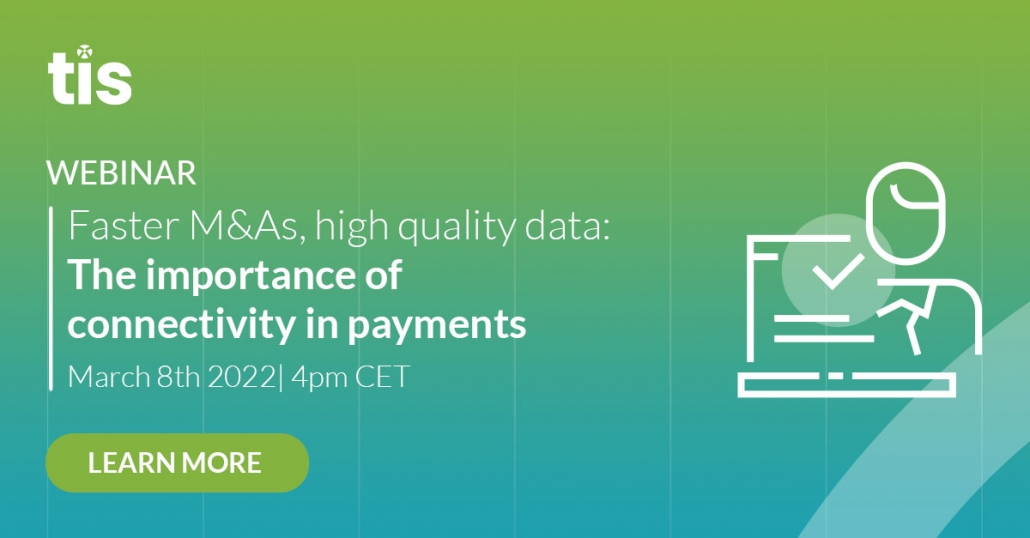
Taking a look at a dictionary, connectivity in computing is described as “the ability of systems, platforms and applications to be connected to each other”.
But what does this mean for payments in particular and how can you benefit from it?
We are very much looking forward to meeting you online: Register here.
23-02-2022 | Eurofinance | treasuryXL |
If your company operates in Africa or is thinking about it, then join us at Effective Finance & Treasury in Africa on March 23rd in London. Now in its 9th year, this intimate event brings together more than 150 senior corporate treasury professionals from leading multinationals – all involved in markets across the continent.
With peer-to-peer learning and knowledge-sharing more important than ever before, join other treasury leaders to debate the key issues, share success stories and gain practical guidance on how to overcome your shared challenges.
From treasury technology to managing liquidity risks, financing strategies, FX, payments and more, the concise 1 day agenda will provide all the information you need to redesign your treasury operations for cost and efficiency, power innovation and support business growth.
Speakers include:
Jan Beukes, Group treasurer, MultiChoice Group Ltd
Omofolake Fawibe, Head of finance, IBS, Danone SA
Ricky Brink, Treasury professional, Siemens SA
Titus Owoeye, Head finance, Fan Milk West Africa
Gain all the tools you need to succeed in Africa in 2022 and beyond.
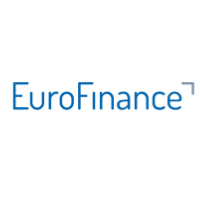
17-02-2022 | treasuryXL | Gtreasury | LinkedIn |
CHICAGO, Ill. – February 17, 2022 – GTreasury, a treasury and risk management platform provider, today announced the launch of the GTreasury Innovation Lab. Expanding and formalizing the culture of technology innovation that GTreasury has always supported within the company, the Innovation Lab is structured to bring significant and differentiated impact to customers through brand new advances in treasury management.
The technology team at GTreasury continuously recognizes potential opportunities for treasury innovation. The company has traditionally held twice-annual hackathons to explore unique and creative ways to advance treasury technology and integrations. Now with the launch of the GTreasury Innovation Lab, each member of GTreasury’s technology team will have a dedicated cycle within the lab, gaining a purpose-built and regular outlet for putting ideas to the test. GTreasury developers also constantly absorb feedback from the customer support team, which gives them insight into the specific challenges that treasurers face. Those insights inform developers’ innovative approaches to increase the capabilities, usability, and overall efficiency of the solutions within the GTreasury platform, both for customers and GTreasury’s internal team that supports them.
“GTreasury has always been forward-looking with the technology and integration capabilities that can enable treasury and finance teams to do more and do it more efficiently,” said Ciarán O’Neill, Director – Innovation Lab, GTreasury.
“We keep one eye on where customers are right now and one eye on where they want to be. Our focus is on making sure that we’re always leveraging the latest technologies and offering future-proof solutions – it’s that philosophy that has led to pioneering creations like SmartPredictions™, our AI-fueled cash forecasting tool. The launch of the GTreasury Innovation Lab accelerates our pursuit of the innovations that it takes to develop and deliver powerful and compelling technological advances to our customers, and we’re excited to get going.”
Technologies born in the GTreasury Innovation Lab will progress through a systemic process designed to ensure the viability of a new solution. Developers at the lab first nurture initial ideas into working proof of concepts. Lab members then vote to select the solutions with the most potential to provide demonstrable day-to-day value for treasury teams. Solutions next enter a validation phase, where ideas are presented to internal stakeholders and customer representatives, including early adopters of a beta product. Validated solutions then move to a production development team to be fully built and integrated as stable enterprise-grade components of the GTreasury platform.
The GTreasury Innovation Lab already has a slate of high-potential solutions in ideation, including many in areas where the introduction of AI/ML capabilities offers tremendous potential. Initial areas for exploration include advances around BI reporting, risk analysis modules, and a reconcilement module offering more automated and accurate reconcilement between forecasted and actual treasury payments.
About GTreasury
GTreasury is committed to connecting treasury and digital finance operations by providing a world-class SaaS treasury and risk management system and integrated ecosystem where cash, debt, investments and exposures are seamlessly managed within the office of the CFO. GTreasury delivers intelligent insights, while connecting financial value chains and extending workflows to third-party systems, exchanges, portals and services. Headquartered in Chicago, with locations serving EMEA (London) and APAC (Sydney and Manila), GTreasury’s global community includes more than 800 customers and 30+ industries reaching 160+ countries worldwide.
16-02-2022 | treasuryXL | Nomentia | LinkedIn |
While the show must go on and treasury and finance teams had a busy life at the start of the year, it’s time to take a look at the ever rapidly changing cash management trends of 2022.
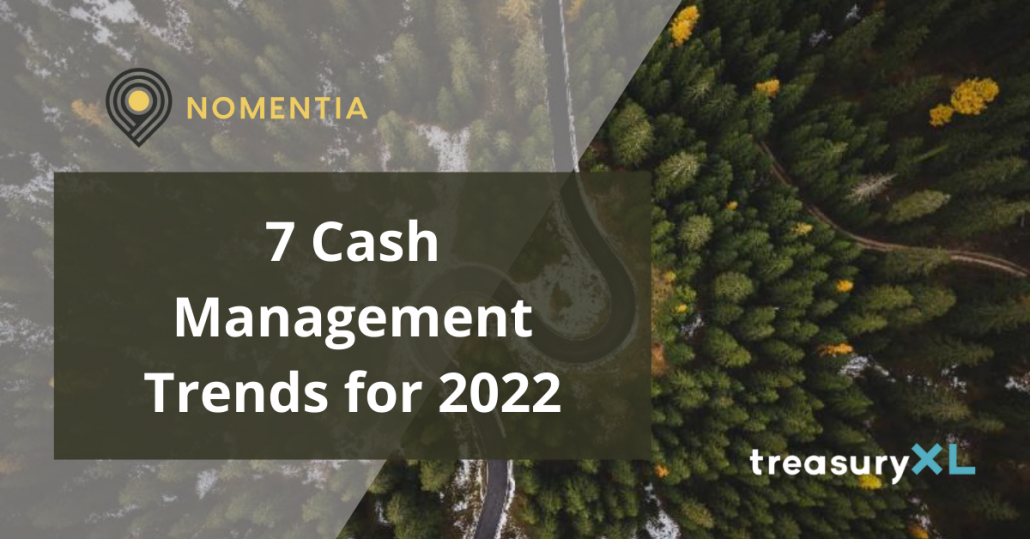
While PWC has predicted that the top priorities for CFOs in 2022 will be advanced cash and liquidity management, technology and digital innovation, fraud and cybersecurity, and business partnering, we also internally discussed what trends we see emerging during the new year.
A year ago, this time, we commissioned a Forrester study, ‘Successful Businesses Excel At Cash Management’, to discover how top decision-makers see the state of cash management. We were ready for some interesting findings but what we found was even more interesting than what we expected.
Clearly, during the past years, a lot has changed as finance and treasury teams had to adjust to the new reality that the global pandemic has brought on all of us. While digitalization has been on the agenda of everybody for some time, it’s been time to speed up the transformation.
While the digital transformation has started in many enterprises already years ago, the work continues to reap the benefits of cloud-based cash and treasury management technology to improve organizational flexibility, cash management processes, and security.
Better digitalized processes do not only make the life of employees easier, but companies can also untap hidden cash, inject accurate forecasting into decision making while improving their day-to-day treasury and finance operations with automation.
While last year enabling home working and ensuring business continuity was a significant driver, for sure, we are moving towards a world where the next items on the cash management wish list will climb up the priority ladder.
Payments are the core of every business process, but compliance is often the main driver for many to improve existing processes. It’s often the same when companies adopt a payment tool for their global payments to improve the efficiency of their global B2B payments. Having a single tool allows more control over how payments are processed, approved, and released to the banks.
Payment efficiency is also the first step for many other cash management priorities, such as better liquidity management and cash visibility
In the process of setting up a payment solution, the hardest part of working with ERPs, existing TMS, and multiple banks is also tackled and can be utilized for implementing new solutions along the way.
Adapting a tool for payment tool can also make centralized user rights management easier.
When we are talking about payments, we must discuss security. During last year, financial fraud cases have been making headlines globally. For compliance, organizations must have the basic security measures in place, but finance and treasury are departments that need more advanced risk mitigation capabilities to tackle financial crime and fraudulent attempts to safeguard the company’s funds and financial stability. To tackle security concerns, partnering up with the information security team and finding the right vendors can provide you with the necessary precautions.
Companies are starting to utilize artificial intelligence and machine learning for catching suspicious fraudulent activity or to spot manual errors.
As all companies could be subject to financial crime, investing in fraud prevention should be a no-brainer. It’s almost like insurance for minimizing the risk of an actual incident.
You will rarely meet someone that would say that bank connectivity is not a challenge. Yet, it’s something that everybody must have in place. In the Forrester study, 76% of the respondents believed that bank connectivity for fetching statements and intraday material is valuable for their treasury and cash management activities.
Connecting to banks is a challenge due to the different communication protocols and file formats. When banks make changes on their end, the existing connectivity should reflect on that too.
This is only part of the challenge. On the other end, there should be a connection to ERP systems (like SAP or other) or to a TMS to fetch all the accounts payable data instantly. This requires working with another communication protocol and another data format.
Between the two different data formats, there must be a data mapping to make sure that the communication between the bank and the organization works flawlessly.
It is challenging enough to set up a bank connection with a single bank. Imagine doing this process with multiple banks
That’s why most organizations are opting for bank connectivity as a service where companies like Nomentia have already over 10 800 bank connections established and expertise to take care of the rest.
Ps.: We have also created a cool video on how easy it can be to outsource the management of your bank connections:
Let’s be honest, cash forecasting with excel is challenging:
Two of the main reasons that are holding back companies from purchasing a solution for liquidity management is the cost and the perception that it’s easy to create cash flow forecasts with spreadsheets and that is how it’s been always done. However, the trend is shifting and more companies start to realize that an actual liquidity management tool would have more benefits.
Using a tool for liquidity makes collecting forecasts and actuals automated and the data can be collected from multiple source systems to help to understand the organization’s current, past, and future liquidity positions to optimize cash flows and FX positions to optimize internal and external funding.
Liquidity management software today is extremely user-friendly and intuitive to use so that users can create reports easily to create accurate reports.
Comparing bank statements against your accounting to make sure the amounts match each other is not too difficult for small firms where their clients and cash flows come from fewer sources and banks. In enterprises, reconciliation may not be so straightforward. In our Forrester survey, 61% of decision-makers say it’s challenging or very challenging to reconcile payments.
Thus, we expect that automation of the reconciliation process will be the star of 2022 so that organizations can streamline the process for faster month-end closing.
According to finance executives, the lack of alignment is the top barrier to better cash management. This is something that at Nomentia we’ve been experiencing firsthand. In a recent interview with TMI, Jukka Sallinen, Nomentia’s CEO said the following:
“Lack of collaboration between different functions within the organization is one of the significant hurdles. There should be more roadmapping and alignment between treasury, finance, and IT. Many solutions provided by software vendors have grown into do-it-all monolithic systems. That, unfortunately, often leads them to be mediocre at best and none of the three departments is entirely happy to work with them. In addition, while there has been lots of talk about open banking and standardization to improve the efficiency of cash management processes, most of these promises have remained unfulfilled.
I believe treasurers want more flexible and fast solutions that can solve their specific challenges and integrate well with their core treasury management system (TMS) and other systems. While it is obviously everyone’s responsibility to look at the big picture, maintaining the growing number of systems and surveying the providers’ landscape is often left to IT. Greater collaboration would be preferable.”
Setting up new solutions, bank connections, or improving security requires cooperation between the different stakeholders and in 2022 they will need to strengthen their alliance for actualizing the strategic benefits of cash management.
Cash management solutions becoming more accessible for businesses of all sizes. As it’s time to digitalize treasury and finance, there are affordable options available for anybody for all the solutions mentioned above. A payment factory, liquidity management, or reconciliation can be easily implemented for a fair price tag in almost any business. The trend has been moving from one-size-fits-all solutions to a hyper-modular approach: you take the solution that you need and integrate it into your existing solution stack so that you can pick the best solutions from different vendors.
Of course, implementation of new cash management solutions will require cooperation and alignment between different departments, prioritization, as well as finding the right strategic vendor that can support the organization’s finance and treasury roadmap.
01-02-2022 | treasuryXL | Nomentia | LinkedIn |
Microsoft Azure customers worldwide now gain access to Nomentia to take advantage of the scalability, reliability and agility of Azure to drive application development and shape business strategies.
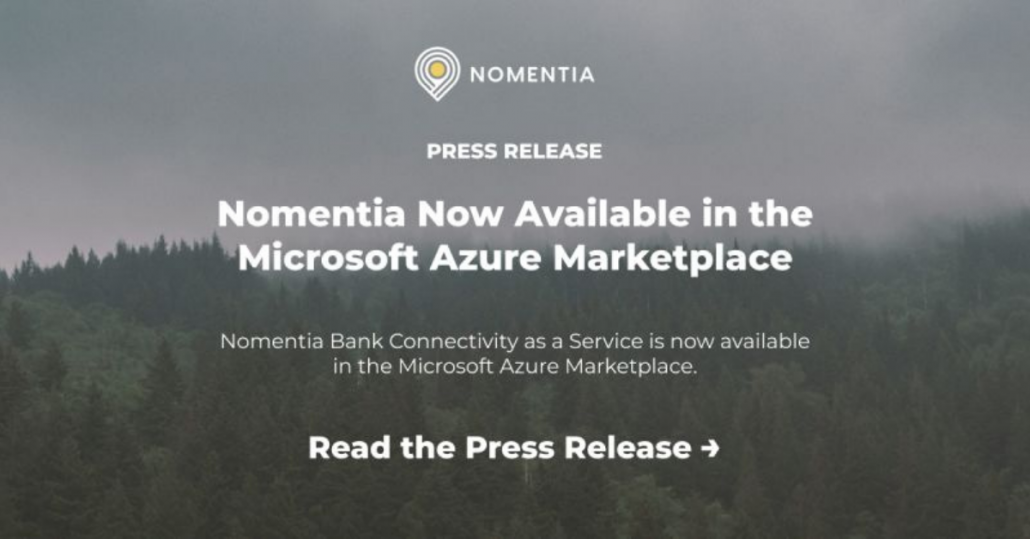
HELSINKI, Finland — February 1, 2022 — Nomentia, a leading European provider of cash and treasury management solutions, today announced the availability of Nomentia Bank Connectivity as a Service in the Microsoft Azure Marketplace, an online store providing applications and services for use on Azure. Nomentia customers can now take advantage of the productive and trusted Azure cloud platform, with streamlined deployment and management.
“Adding Nomentia to Microsoft Azure Marketplace will help IT departments achieve desired connectivity between banks and internal systems, faster than ever before” Anna-Lisa Natchev, Chief Growth Officer of Nomentia
“Nomentia is addressing some of the major challenges treasury, finance and IT teams are facing during the digitalization and transformation of treasury and finance processes. We not only take care of ERP integrations, but also offer unrivaled bank connectivity-as-a-service across the market. Adding Nomentia to Microsoft Azure Marketplace will help IT departments achieve desired connectivity between banks and internal systems, faster than ever before. Using Nomentia’s bank connectivity-as-a-service can significantly reduce IT burden and ensure treasury and finance departments can start building better processes to improve operations, data output quality, security and compliance assurance,” says Anna-Lisa Natchev, Chief Growth Officer of Nomentia.
“Through Microsoft Azure Marketplace, customers around the world can easily find, buy, and deploy partner solutions they can trust, all certified and optimized to run on Azure,” said Jake Zborowski, General Manager, Microsoft Azure Platform at Microsoft Corp. “We’re happy to welcome Nomentia’s solution to the growing Azure Marketplace ecosystem.”
The Azure Marketplace is an online market for buying and selling cloud solutions certified to run on Azure. The Azure Marketplace helps connect companies seeking innovative, cloud-based solutions with partners who have developed solutions that are ready to use.
About Nomentia
Nomentia is a category leader within European treasury and cash management solutions. Nomentia’s mission is to provide unparalleled cloud treasury and cash management solutions for and with our customers. Today, Nomentia is solving the challenges of modern treasurers and cash managers across 2,000+ businesses in over 80 countries, processing more than 800 billion euros annually. Nomentia solutions specialize in global payments, bank connectivity-as-service, cash-forecasting and visibility, bank account management, financial process automation, treasury workflows, FX risk, in-house banking, and trade finance. For more information, visit www.nomentia.com.
For more information, press only:
Anna-Lisa Natchev, Nomentia, Chief Growth Officer, +358 50 413 0704, [email protected]
Barbara Babati, Nomentia, Head of Marketing, +358 40 762 3356, [email protected]
01-02-2022 | treasuryXL | Refinitiv | LinkedIn |
Andrew Hollins, Director of Corporate Treasury Proposition at Refinitiv, brings you a round-up of the latest Corporate Treasury Data Insights, including corporate treasury activity during COVID-19 illustrated through Refinitiv’s usage data, a Refinitiv report on ESG risk and whether carbon markets matter to COP26.
For more data-driven insights in your Inbox, subscribe to the Refinitiv Perspectives weekly newsletter.
Refinitiv’s usage data paints a fascinating picture of corporate treasury activity throughout the pandemic. As events unfolded, we saw interesting and distinct dynamics play out.
We’ve discerned three phases of the pandemic.
The standout feature of this initial period was the focus on credit risk data and analytics, highlighted by an unprecedented increase in usage of the Credit Default Swaps app – 155 percent in EMEA, and 120 percent in Asia and the Americas.
Demand for corporate financial data also grew strongly – notably company fundamental data (usage up 81 percent), private company data (usage up 33 percent), sectoral data, and peer analysis (usage up 113 percent).
Conversely, during this initial phase, we saw a distinct fall in demand for ESG and LIBOR-related data and analytics.
From June to September 2020, activities aimed at boosting cash balances were very much apparent. Our data showed a notable acceleration in corporate debt issuance.
In addition, there was also another, even bigger, jump in demand for company fundamental data with usage of key ratios and cashflow data growing by 160 percent and 175 percent respectively.
Emerging from the pandemic demand for ESG data and analytics is once again rising strongly. Between December 2020 and March 2021, it has grown by 93 percent to stand well above pre-COVID-19 levels.
This trend is likely to continue its upward trajectory given the rapidly evolving regulatory and demand-led factors that seem to be driving the focus on sustainability.
Refinitiv unpacks more of our usage data insights in a new masterclass series produced in collaboration with TreasuryToday.
Log-in or register at TreasuryToday to follow the series
The far-reaching consequences of COVID-19 have forever changed the risk landscape, and rising levels of third-party risk now demand urgent attention.
Persistent gaps in formal due diligence must clearly be addressed, but a broader sea change is needed: both financial institutions and corporates need to adopt a more holistic approach to risk management – one that incorporates environmental, social and governance considerations as a fundamental tenet of the risk mitigation process, rather than as a separate silo.
Read the report: Risk mitigation and the pivotal role of ESG
Carbon markets are a key tool for countries to cut their greenhouse gases and meet their Paris Agreement commitments.
The cost of polluting is rising in Europe, parts of North America, South Korea and New Zealand. Most likely it will do so in China, the latest country to launch a national emissions trading system.
Read the blog: Why do carbon markets matter to COP26?
The COVID-induced rigidities in the U.S. labour market are easing, but the labour market remains extremely tight, implying potential upwards pressure on inflation from wages.
What can the Beveridge curve tell us?
There are textbook ways for investors to beat inflation. Unfortunately, we do not live in a textbook world.
Inflation chatter is always a thing, but the shocks are now coming thick and fast.
Decades of globalisation had muted inflation, and the last time the Consumer Price Index (CPI) topped 5 percent was just over a decade ago.
27-01-2022 | treasuryXL | TIS | LinkedIn |
This article reviews the reasons why an Accounts Payable (AP) team’s stake in managing enterprise payment and reconciliation activity is critical for large companies before examining why AP departments do not always receive the internal prioritization or attention they deserve as enterprises make payments and financial technology investments. Finally, this article concludes by evaluating how the TIS platform equips AP — along with treasury, finance, accounting, and other internal groups, to manage and control each of their respective functions regarding enterprise payments within the solution of their choice, thereby largely eliminating the need to pick and choose which departments receive budget or funding.
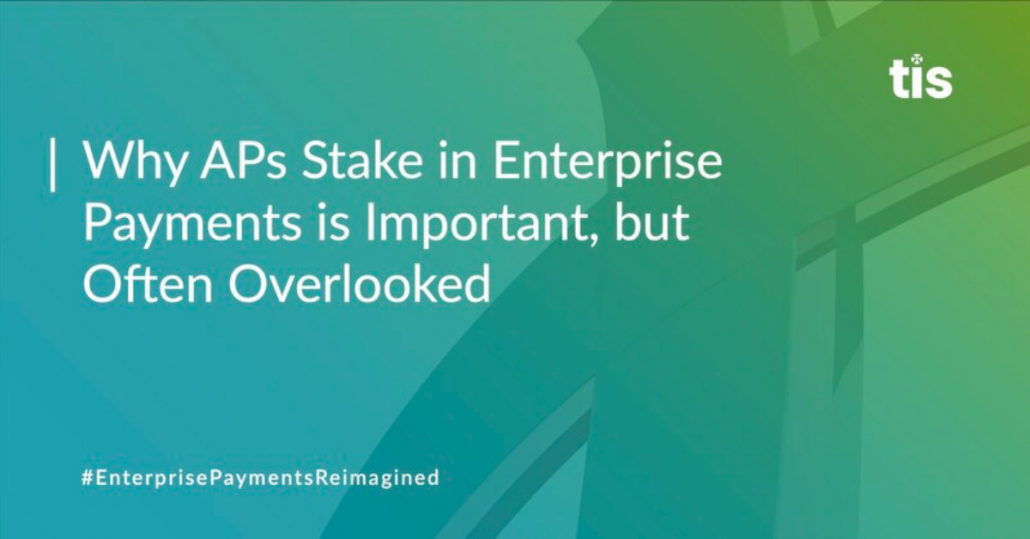
For those who may be unfamiliar or need a quick refresh, the general role of an Accounts Payable (AP) department is as follows:
When a company purchases goods and services from a supplier or vendor on credit, the accounting entry is referred to as an Account Payable (AP). On a balance sheet, it appears under current liabilities. As such, an enterprise’s AP department is responsible for ensuring these payments owed by the company arrive to suppliers and other creditors in a timely fashion.
Depending on the company’s size and scope, the AP department may consist of just one or two individuals, or up to several dozen. Most of the time, AP staff operate as a subset of the finance department and work within an ERP or similar technology solution to manage the company’s global payables (i.e. supplier or vendor invoices) and ensure that outbound payments are generated and executed according to the outstanding payments that are due to these parties.
As AP groups go about managing their roles, the main benefit to their organization is that outstanding payment requests are effectively fulfilled without violating deadlines or contracts. There is often a vendor relationship aspect attached to this benefit as well, provided that invoices are paid on time. Additionally, an optimized AP group can help take advantage of early-pay discounts or other types of incentives to earn additional revenue, and can also help identify fraudulent invoice requests and other security threats. For enterprises making hundreds or thousands of payments every week, these benefits are essential.

However, despite the important role that AP groups play and the critical nature of their work, the reality is that their needs are rarely prioritized over other financial stakeholders and departments internally.
Let’s explore further.
As an enterprise’s financial priorities and initiatives get championed by internal executives and leaders, who is most commonly advocating for AP?
In other words, which of an enterprise’s chief financial stakeholders are actively prioritizing the needs of the AP department relative to other internal departments and groups?
Although some AP managers or directors might get a say in largescale technology projects and Controllers or Treasurers may work closely with AP to ensure process cohesion, the reality for many enterprises is that AP departments rarely have a high-ranking executive or financial stakeholder that resides directly within their team.
For example, while the Treasurer often can communicate directly with the CFO and accounting groups have directors that are given a direct line for influencing important decisions, the AP group does not.
Of course, this is not to say that the AP department is always getting completely overlooked, and to be fair, other financial departments like Procurement might suffer from a similar conundrum, depending on the structure of the enterprise. However, in cases where the AP group is clearly outranked by other stakeholders, the impetus is on leaders in treasury and accounting, as well as the CFO directly, to ensure that their needs and priorities are addressed.
As noted above, the benefits of helping AP optimize its function include increased revenue and cost savings through early payment opportunities like dynamic discounting. With the right technology and workflows, AP can also play a critical role in detecting fraudulent invoices and payment requests and maintaining the organization’s good standing regarding vendor and supplier contracts and relationships.

For enterprises that are able to address AP’s needs in an effective fashion, the above benefits can be instrumental in boosting revenue, maintaining accurate financial records, and preventing fraud. However, without the proper attention, these benefits can quickly dissipate and result in a myriad of issues. This is especially the case if AP is not provided with the right technology solutions or integrations to perform their duties, as detailed further below.
Upon examining the typical financial responsibilities that AP teams manage, the reality is that their technology needs are not that different from other financial groups, especially those of accounting.
In most cases, enterprises will have at least one (if not multiple) ERP system deployed globally. These ERPs often provide the perfect backdrop for AP to function, as global financial data can flow directly into these platforms to make for easier oversight and control. In circumstances where enterprises have strategically developed their financial technology stack to optimize the data flowing into these ERPs, the AP department can subsequently benefit from access to the same information that accounting and other departments do. And as invoices, bank statements, and payment statuses flow from various entities, vendors, and banks into the ERP(s), tasks like payment generation and invoice matching become much easier for AP to automate and control.
However, without the proper bank connections, system integrations, or authentication and security settings, these ERPs and disparate technology stacks can quickly become the bane of AP’s existence and lead to more headache than efficiency.
Here’s why.

For global enterprises with dozens of entities and back-office systems, as well as thousands of suppliers, vendors, and bank accounts, gathering and disseminating global financial data in a timely fashion represents a massive undertaking. For many companies, issues start to occur when their ERP is not properly integrated with all their banks, vendors, or the corresponding systems at regional entities and units. Whether due to constant M&A activity, regular implementation of new solutions, or simply a lack of IT budget and bandwidth, maintaining all the right system connections requires constant upkeep.
To make matters worse, some AP groups today are still relying on Excel, email, or paper statements, which magnifies the challenges of meeting contractual deadlines, identifying false invoices, and successfully obtaining early-pay discounts and incentives.
Ultimately, scenarios where AP must manually pull invoices and bank statements to perform their duties or where they wait days or weeks to receive data from regional offices and banks can render the benefits of their department almost entirely obsolete. And in today’s fast-paced, highly-digital environment, the simple truth is that if your enterprise is struggling to locate and aggregate financial data, then you are likely significantly behind your peers in terms of AP process efficiency.
Given what we’ve seen with many AP departments lacking the internal status to advocate for better technologies and workflows on their own, and because many enterprises might not be willing to invest in an AP-specific solutions, the best option many companies have for meeting AP’s technology needs without exasperating their budget is to invest in payments and banking technologies that can streamline the collection, aggregation, and analysis of payments and finance data for ALL internal stakeholders.
Of course, departments like AP and accounting will likely end up doing the brunt of their work in an ERP. However, by adding a global payment and bank connectivity hub to their technology stack, enterprises can ensure that all the data these groups need to do their jobs can flow into the ERP in an optimized and timely fashion.
Today, these global payments optimization capabilities are exactly what TIS offers enterprises with our Enterprise Payment Optimization (EPO) platform. The manner in which our solution optimizes the AP function while also streamlining payments, liquidity, compliance, and banking functions for Treasury, Accounting, Legal, and more is highlighted below.
TIS’ Enterprise Payment Optimization platform is a global, multi-channel and multi-bank connectivity ecosystem that streamlines and automates the processing of a company’s payments and subsequent reporting across all their global entities, banks, and financial systems.
By sitting above an enterprise’s technology stack and connecting with all their back-office, banking, and 3rd party solutions, TIS effectively breaks down department and geographic silos to allow 360-degree payments and cash visibility and control. This includes visibility to executed vs outstanding transactions, as well as to cash positions and bank statements.
To date, the ~200 organizations that have integrated TIS with their global technology stacks have achieved near-100% real-time transparency into their payments and liquidity. This structure benefits a broad variety of internal stakeholders and also enables each group to access information through their platform of choice, since the data that passes through TIS is always delivered back to the originating systems.
This systematically controlled payments workflow is managed by TIS for both inbound balance and transaction information and outbound payment instructions. Data can be delivered from any back-office system via APIs, direct plug-ins, or agents for transmission through TIS to banks and 3rd party vendors. This means that for AP teams that use an ERP, payments and liquidity data is transmitted in near-real-time from TIS into their modules, where they can then perform automated reconciliation, payment generation, and other tasks as their role dictates.
Because of the deep connections that TIS maintains with internal systems such as ERPs or TMSs, external banks, and 3rd party vendors / service providers, the process of managing payments is simplified for every internal stakeholder. C-suite executives, treasury, accounting, AP, legal, HR, and other key personnel can access whatever financial data they need, exactly when they need it. And by automating this flow of information for both inbound and outbound payments, TIS provides the control and flexibility that enterprises need to function at their highest level.
For AP teams specifically, the extensive experience and unparalleled integration capabilities provided by TIS enable enterprises to streamline their methods for managing payments, invoicing, and reconciliation. Additional security controls, invoice inspection tools, and payment fraud alerts are implemented to ensure compliance and cohesion at every point in the process. And because the functionality provided by TIS helps all enterprise financial stakeholders, organizations that adopt TIS typically receive unanimous buy-in because each group recognizes the benefits they will obtain through TIS’ implementation.
In the digital world of enterprise payments, TIS is here to help you reimagine and simplify. For more information about how TIS can help you transform your global payments and information processes and optimize your AP function without breaking the bank, contact us to learn more.
